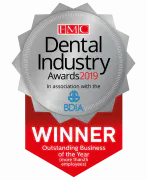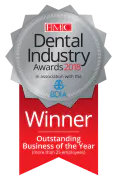Portman Dental Care Awards






10th March 2020
Have you noticed that your teeth maybe aren’t quite as white as they used to be. Maybe you noticed in a photo, or after applying your favourite red lipstick. But what can be done? In this blog we break down the different types of stain, how to prevent stain and what can be done to get rid of it.
Firstly let’s explore the different types of stain.
This is the superficial stain that builds up on the tooth surface. This is most commonly due to tobacco use and exposure to coloured particles in food and drink. Not cleaning teeth well can also cause extrinsic stain- plaque, which is yellowish in appearance, traps staining particles which become incorporated into the plaque.
Most people are aware that tea, coffee and wine stain your teeth, but there is a whole host of foods and drinks that can lead to stain if consumed on a regular basis. Here is a list of the top 10 offenders:
As the name suggests this type of stain comes from within the tooth itself, often from well beneath the surface. It varies widely in appearance – it can be dark and localised to one spot, or widespread and present as a yellowish mottled appearance. Here are some of the causes of intrinsic stain:
As we age our teeth will gradually darken in shade, this is due to a combination of both intrinsic and extrinsic staining. As mentioned above the layer under the enamel outer coating of the teeth is dentine, a layer that is naturally darker in appearance. With general wear and tear on the teeth, the dentine will eventually shine through.
So now we understand the different types of tooth stain, how do we get our teeth whiter again?
These stains are preventable. The obvious change is to reduce or eliminate the consumption of the foods and drinks listed above, and keep your teeth free of plaque. If tea and coffee is your nemesis then diluting the drink with water/milk and swirling with water after drinking can help stop stain from accumulating. This goes for the consumption of any staining food or drinks, although I’m sure no one will want to dilute their red wine with water, small swirls with water after drinking will help reduce stain. Another stain reducing tip is to chew chewing gum which has xylitol in it, this encourages saliva production which naturally cleanses the mouth. If drinking a fizzy drink use a straw. With smoking or the use of tobacco based products reducing and elimination is the best option. If you wish to quit smoking a discussion with your doctor or pharmacist about nicotine replacement therapies could help you on your way to quitting for good.
Whitening toothpastes do not whiten teeth from within but they can help remove extrinsic stain. However, it is worthwhile remembering that these tooth pastes are usually more abrasive on tooth enamel so we wouldn’t recommend using them every time you brush, 3-4 times per week should be enough.
Reducing plaque levels with a good home cleaning routine prevents the buildup of stain within the plaque.
Regular dental hygiene appointments are important to help keep on top of staining. In these appointments our hygienist removes stain with ultrasonic cleaning and using a dental polishing paste. If the stain is heavy we recommend the use of ‘Airflow’ polishing, using a combination of highly compressed water, air and fine powder particles to lift stain off your teeth.
To treat intrinsic stain, in other words dark teeth,we recommend that you arrange an appointment to discuss your specific staining and needs. This nearly always starts with professional tooth whitening. The process of tooth whitening breaks up the stain molecules deep inside the tooth. We will assess the colour of your teeth, and the reasons for the staining, then take photos. We make whitening trays (like very thin gumshields) for you in which you use a whitening gel at home. Whitening at home continues until you are happy with the colour of your teeth, with monitoring by the dentist. The colour change can last up to 3 years, but once you have your trays it is easy to keep your smile bright.
It is worth noting that whitening isn’t suitable for everyone, as whitening doesn’t change the colour of existing crowns and fillings .(although their appearance can improve) . Tooth whitening is safe and preserves tooth material.
Other options to treat stained dark teeth are cosmetic bonding, veneers and tooth crowning, and these options can be discussed. For more information on teeth whitening in Edinburgh please call us on 0131 225 7576.
Portman Dental Care Awards





